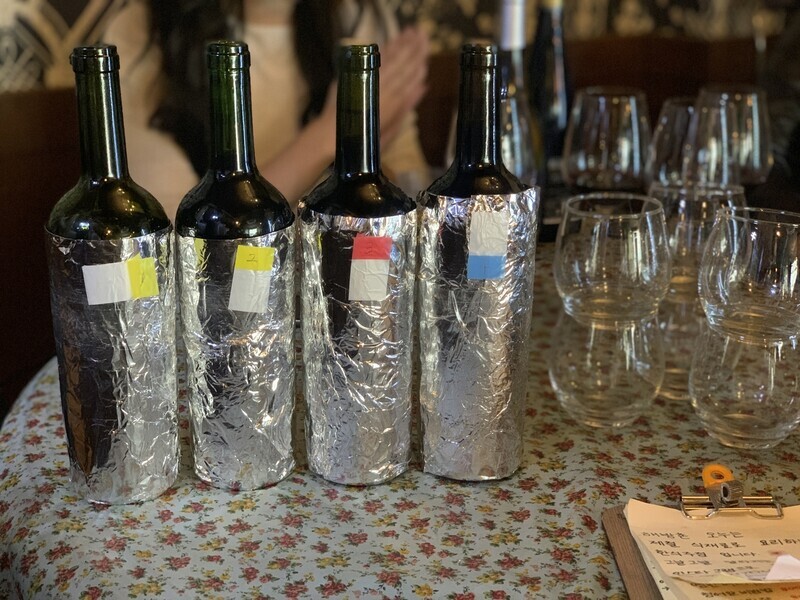hankyoreh
Links to other country sites 다른 나라 사이트 링크
Is the most expensive bottle of wine always the best one?

Bottles of wines selling for 30,000 won (US$26.95), 50,000 won (US$44.92), 70,000 won (US$62.89), 100,000 won (US$89.85), and 150,000 won (US$134.77) are assembled in one place and their labels are covered. Participants taste only the wine, without any other information. Can they guess the variety or region? Will there be a “twist” where the cheapest bottle is found to be more delicious than the most expensive one?
A group of wine connoisseurs recently staged a blind tasting event to answer these questions. It assembled five bottles ranging in price from 30,000 won to 150,000 won, taking care to completely obscure the label as well as any other bottle characteristics that might enable participants to guess its identity. Numbers were assigned, with each participant drinking in turn and sharing their impression.
“This seems one seems kind of soft, like a Merlot.”
“The musty scent isn’t really my thing. I think the wines with this kind of bouquet are Shiraz varieties from France’s Rhone region.”
“This one seems to be a New World wine from somewhere like Chile or Argentina.”
While the distinctions can be difficult even for wine experts to make, the participants guessed at the regions and varieties based on their own past wine-drinking experiences.
They also tried to guess the wine’s price tag. All six of the wine tasters agreed on which were the 30,000-won, 50,000-won, and 150,000-won wines, with opinions split four-to-two on the 70,000-won and 100,000-won wines. They additionally assigned numbers to indicate which wine best suited their preferences. Here, the preferences varied considerably, given the differences in tastes.
After the varieties, regions, and prices had been guessed and the preferences registered, the labels and prices of the different wines were individually revealed. Surprisingly enough, participants accurately guessed the region and variety for three of the five. While they may have been relying on fragmented memories of wines drunk in the past, it appears that all that time had not been spent in vain.
I was most curious about the prices, where I expected some kind of “twist.” But there was none: the six participants’ unanimous selections for the 150,000-won wine and the 30,000-won wine were on the money. I might have preferred to see the opposite be true.
But the wine preferences did not conform to the order based on prices. Since the participants were unaware of the price, they had been able to focus purely on the taste; since they didn’t have any information about the variety or region, they had an unprejudiced opportunity to drink wines they would not normally favor. I recommended having these kinds of blind tastings from time to time. The more you work to “guess right,” the more you are able to draw upon your past experiences and the characteristics you recognize from wines in the past; most of all, you can focus on the wine’s taste without prejudice. Sometimes just covering the label over with a piece of foil can double your enjoyment.
By Shin Ji-min, Hankyoreh 21 reporter
Please direct comments or questions to [english@hani.co.kr]

Editorial・opinion
![[Column] Park Geun-hye déjà vu in Yoon Suk-yeol [Column] Park Geun-hye déjà vu in Yoon Suk-yeol](https://flexible.img.hani.co.kr/flexible/normal/500/300/imgdb/original/2024/0424/651713945113788.jpg) [Column] Park Geun-hye déjà vu in Yoon Suk-yeol
[Column] Park Geun-hye déjà vu in Yoon Suk-yeol![[Editorial] New weight of N. Korea’s nuclear threats makes dialogue all the more urgent [Editorial] New weight of N. Korea’s nuclear threats makes dialogue all the more urgent](https://flexible.img.hani.co.kr/flexible/normal/500/300/imgdb/original/2024/0424/7317139454662664.jpg) [Editorial] New weight of N. Korea’s nuclear threats makes dialogue all the more urgent
[Editorial] New weight of N. Korea’s nuclear threats makes dialogue all the more urgent- [Guest essay] The real reason Korea’s new right wants to dub Rhee a founding father
- [Column] ‘Choson’: Is it time we start referring to N. Korea in its own terms?
- [Editorial] Japan’s rewriting of history with Korea has gone too far
- [Column] The president’s questionable capacity for dialogue
- [Column] Are chaebol firms just pizza pies for families to divvy up as they please?
- [Column] Has Korea, too, crossed the Rubicon on China?
- [Correspondent’s column] In Japan’s alliance with US, echoes of its past alliances with UK
- [Editorial] Does Yoon think the Korean public is wrong?
Most viewed articles
- 1‘We must say no’: Seoul defense chief on Korean, USFK involvement in hypothetical Taiwan crisis
- 2N. Korean delegation’s trip to Iran shows how Pyongyang is leveraging ties with Moscow
- 3‘Weddingflation’ breaks the bank for Korean couples-to-be
- 4[Column] Park Geun-hye déjà vu in Yoon Suk-yeol
- 5Korea sees more deaths than births for 52nd consecutive month in February
- 6[Guest essay] The real reason Korea’s new right wants to dub Rhee a founding father
- 7[Column] The clock is ticking for Korea’s first lady
- 8[Column] Has Korea, too, crossed the Rubicon on China?
- 9Why Korea shouldn’t welcome Japan’s newly beefed up defense cooperation with US
- 10Will NewJeans end up collateral damage in internal feud at K-pop juggernaut Hybe?